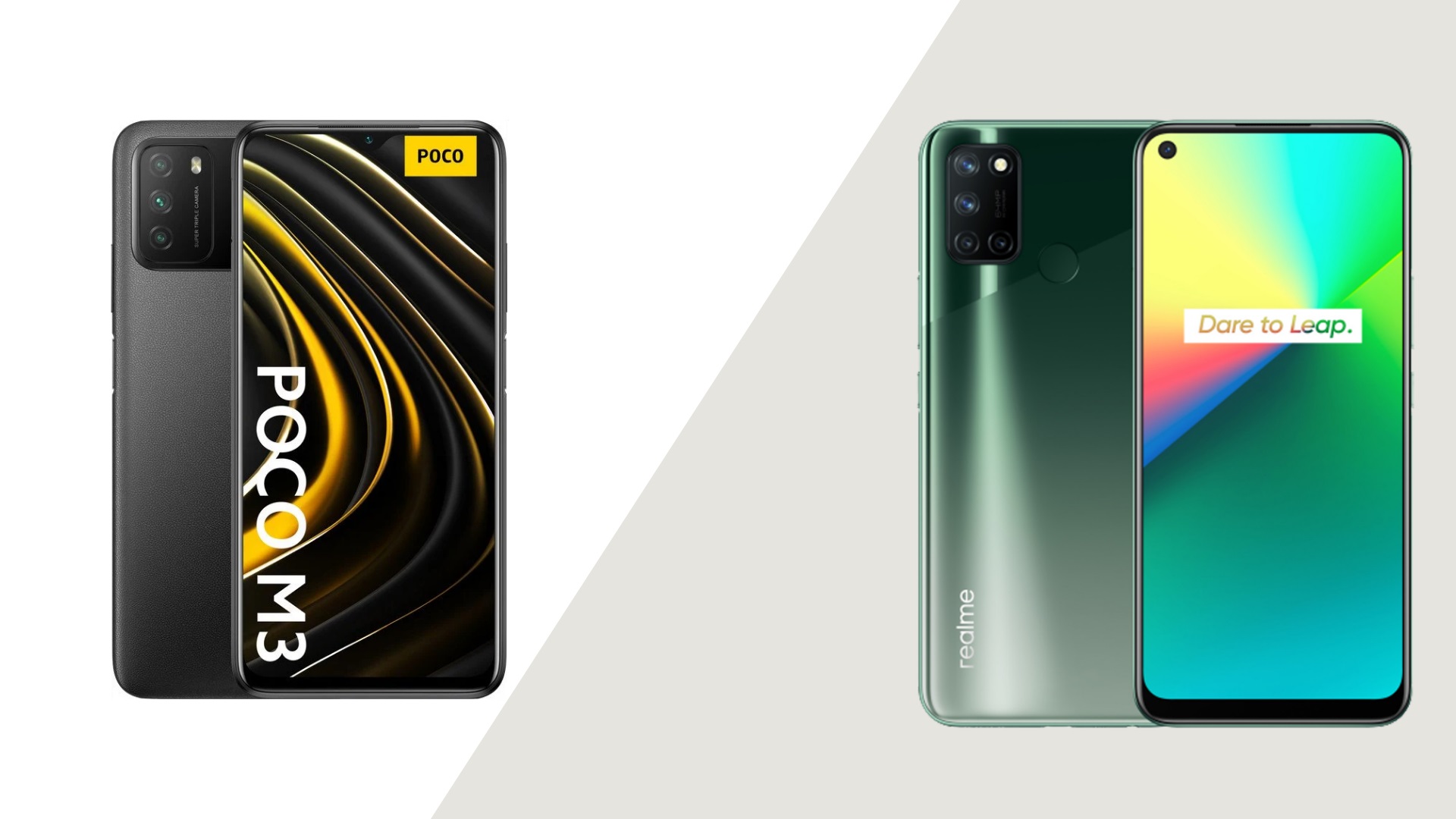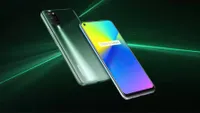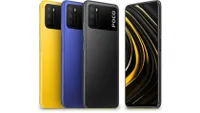Poco M3 vs Realme 7i: Comparing the budget phones
Which one should you buy?

Poco has debuted its new budget smartphone – Poco M3 in India and interestingly it comes with slightly beefed-up specifications over its Chinese variant. Among the key highlights are its big battery, Snapdragon 662 chipset and the triple camera setup.
With its predecessor the Poco M2 still selling in numbers, Poco M3 takes on the likes of Redmi 9 Power, Oppo F17 and Realme 7i. Also keeping the price point and specifications in mind, we will do a quick comparison between the two phones and lets us see which phone deserves your money?
- Best budget phones in India under Rs 10,000 for January 2021
- Best phones under Rs 15,000 in India for January 2021
- Best phones under Rs 20,000 in India for January 2021
Poco M3 vs Realme 7i – Price in India
The Poco M3 comes in a couple of variants when it comes to storage and memory. The base variant with 6GB RAM and 64GB internal storage is priced at Rs 10,999 in India and the price goes up to Rs 11,999 for 6GB RAM and 128GB storage variant. The handset will start retailing in India from February 9th onwards via Flipkart in Power Black, Poco Yellow, and Cool Blue colour options.
Realme 7i, on the other hand, was launched in September last year and comes in two variants with 4GB RAM and 64 GB storage priced at Rs. 11,999 and the variant with 4GB RAM and 128GB storage retails at Rs. 12,999. The base variant of Realme 7i has been unavailable on Flipkart since some time and there is no clarity around its availability. The phone is available in a couple of colour options Fusion Green and Fusion Blue.
Check the Realme 7i on Flipkart
64GB: Rs 11,999| 128GB: Rs 12,999
Check Poco M3 on Flipkart
64GB: Rs 10,999| 128GB: Rs 11,999
Poco M3 vs Realme 7i – Design
When it comes to design the Poco M3 has a fresh design and offers bold colour options that may be fancied by the young audience looking to buy a new phone but have budget constraints. The Poco M3 has a dual-tone finish and apart from the bold branding that sits on the massive camera island, the rear panel is clean since the fingerprint sensor has been placed under the power button on the right.
The Realme 7i also carries a dual-tone finish though extremely subtle when compared to the Poco M3’s bold design. It also has a gradient finish and rear-mounted fingerprint sensor. The overall design looks common since the phone was launched around 6 months back and we’ve seen quite a few phones with similar design language.
On the front, the Poco M3 sports a waterdrop notch to house the selfie camera while the Realme 7i comes with a punch hole cut out to host the front-firing camera. Both the phones have a plastic back and while the Realme 7i has a glass finish, Poco M3 sports a faux leather finish.
Sign up for breaking news, reviews, opinion, top tech deals, and more.
Poco M3 vs Realme 7i – Specifications
| Feature | Poco M3 | Realme 7i |
|---|---|---|
| Processor | Snapdragon 662 | Snapdragon 662 |
| Display | 6.53-inch Full HD+ 19.5:9 LCD screen | 6.5-inch HD+ LCD screen with 90Hz refresh rate |
| RAM | 6GB | 4GB |
| Storage | 64GB | 128 GB | 64GB | 128 GB |
| Camera (rear) | 48MP + 2MP + 2MP | 64MP + 8MP + 2MP + 2MP |
| Camera (front) | 8MP | 16MP |
| Battery | 6000 mAh (18W fast charge) | 5000 mAh (18W fast charge) |
| OS | MIUI 11 on Android 10 | Realme UI on Android 10 |
The Poco M3 can be called a “redesigned” Redmi 9 Power. The phone comes with Snapdragon 662 chipset coupled with 6GB of RAM and up to 128GB of internal storage. It sports a 6.53-inch full-HD+ display, 19.5:9 aspect ratio with a 90.34 percent screen-to-body ratio, and standard 60Hz refresh rate. The supports storage expansion of up to 512 GB via a dedicated microSD card slot.
As for the optics, the Poco M3 comes with a triple rear camera setup with the primary 48-megapixel sensor, 2-megapixel ultra-wide-angle sensor, and a 2-megapixel macro sensor. And to help you with your selfies and video calls, there is an 8-megapixel selfie shooter present upfront. The Poco M3 runs on MIUI 11 that runs on more than a year Android 10 out of the box and comes with a 6000 mAh battery with support for 18W fast charging.
As for connectivity, the Poco M3 supports Dual sim connectivity, 4G LTE, Wi-Fi, Bluetooth, and Type-C port for charging and data transfer.
The Realme 7i comes with the same Snapdragon 662 chipset but is coupled with 4GB of RAM and up to 128 GB of internal storage. Thankfully, like the Poco M3, the internal storage on the 7i is expandable and the phone has a dedicated microSD card slot. It comes with a 6.5-inches boasting HD+ resolution and 90Hz refresh rate.
In terms of cameras, the Realme 7i comes with a quad-camera setup with the primary 64-megapixel shooter coupled with an 8-megapixel ultra-wide sensor and a couple of 2-megapixel B/W sensor and 2-megapixel macro sensor. While on the front you have a 16-megapixel camera for selfies and video calling housed in a hole punch cutout.
The Realme 7i boasts a 5,000 mAh battery that supports 18W fast charging over a Type-C port. This phone also runs on a dated Android 10 based Realme UI. As for connectivity, the Realme 7i supports Dual sim connectivity, 4G LTE, Wi-Fi, Bluetooth, and Type-C port for charging and data transfer.
Poco M3 vs Realme 7i - Take away
It's pretty clear that both the Poco M3 and Realme 7i are quite similar when it comes to specifications, however, each has its highlights as well.
Talking about the Poco M3, it has a new design, FHD+ display panel, stereo speakers, a bigger battery and comes with a minimum of 6GB of RAM. As such, Poco targets all the weak points of the Realme 7i and one-ups them.
While the 90Hz refresh rate, hole-punch camera and better camera specifications are a few features that swing the tide in the favour of Realme 7i.
Overall, if you remove those macro and depth sensors, which are rather useless, to say the least, from both the devices, the camera configuration on the Realme 7i is way better than that of the Poco M3.
So if your primary focus is photography and do not mind paying a bit more to get a smoother screen experience, then you can go for the Realme 7i.
But, if the pricing and modern look weigh higher on your list then the Poco M3 is the device to go with.
- Here are some of the Upcoming smartphone launches in India for February 2021
Get up close with consumer tech news that you can use, latest reviews and buying guides. Follow TechRadar India on Twitter, Facebook and Instagram!

Jitendra has been working in the Internet Industry for the last 7 years now and has written about a wide range of topics including gadgets, smartphones, reviews, games, software, apps, deep tech, AI, and consumer electronics.

